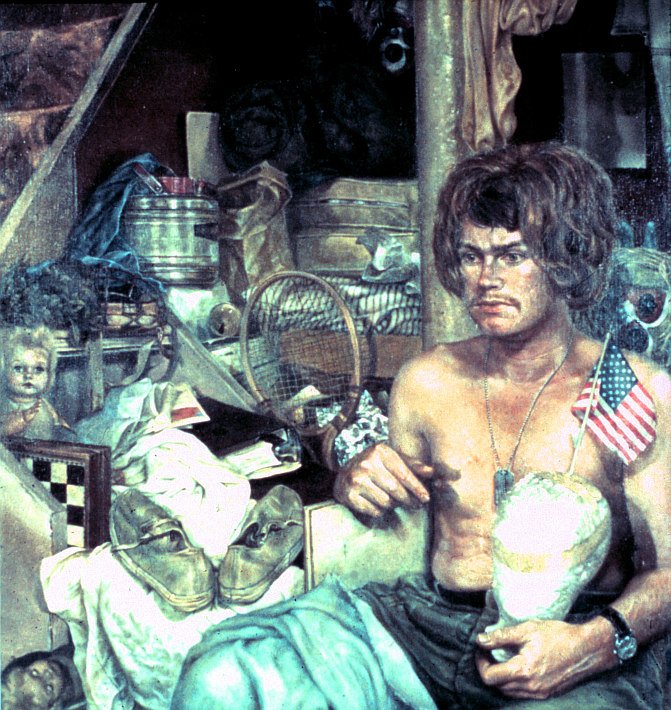

The painting “Triumphal Return” was done when the Vietnam War was nearing its zenith. The most vocal of all sentiments was that of 'anti-war'.
The most immediate experience which inspired my theme was when I, by chance, attended the yearly ceremony of the local American Legion, Long Island New York, in which the entire procession was conducted seemingly most diffident and eventlessly hastened up way. The National Anthem was sung in hushed voices in disarray. The white rectangular military caps looked as forlorn as the brown of deserted piers.
There was something moved me deep enough to plunge into this, my first major work, which demanded total concentration for four months working every night (I painted during night.)
Preparation of painting surface was done by mixture of opaque and transparent regular oil color pigments produced by Windsor and Newton and Grumbacher which eventually took the hue of reddish dark brown. I used a commercially prepared cotton small grain canvas.
On this prepared surface, approximately 1~2 mm thickness of the pigment after sufficient dryness was achieved, I first transferred the final sketch of the theme using medium strength charcoal. Approximately 3 or 4 coats of a fixative were applied before the execution of final under drawing cartoon) by oil colour, mixture of burnt umber and Prussian blue in various composition ratios to shortening drying period, with pure turpentine as medium.
When the under-drawing was sufficiently dry, I began first application of painting.Medium: pure turpentine plus linseed oil. Ratio, approximately 2 turp/1 linseed. Pigments used were burnt umber, optional Prussian blue and yellow ochre. After adequate surface dryness of the so far monochromatic sketched first coat (with the entire pictorial plane equally developed), the second coat was applied to achieve chromatic “mapping” according to the psychological connotation and aesthetic atmosphere desired by the theme.
I began by using opaque-est pigments such as yellow ochre, cobalt blue, burnt sienna etc, and quick drying properties like umbers, prussian blue, naples yellow mixed by turp and linseed with aforementioned concoction ratio. At this stage the entire effect of the painting still presents monochromatic, relief-like quality, although proper hues were ascribed to the major areas of the composition. I call it “the view at dusk” for its similarity in chromatic effects.
At this stage the painting surface began to appear “realistic” Since the canvas dimensions of “Triumphal Return” is rather large, 50" by 60", the earlier applications became dry enough to accept further application by the time this coat was finished. Once this stage is achieved, real part of “painting” begins: rendering of the objects with utmost objective fidelity. The method I used for this purpose was glazing (thin application of transparent pigment) techniques employing pigments of high transparency such as alizarin crimson, ultramarine, prussian blue, verdian green, chrome yellow, aureolin, zinc white, ivory black, etc.
When the entire pictorial surface was covered and safely dried, I used larger brushes such as 1inch or 11⁄2 inch flat, sable and fanshaped and or pig hair brushes, employing “wash” technique with transparent color, which is similar to second coating, to go over the entire canvas in order to achieve thematic and pictorial unity. When the surface becomes adequately dry, 3~4 coat of “retouch” was given to the entire pictorial surface.
The final finish varnish was applied later, after exhibiting at 1st NY International Art Show
Photo album created with Web Album Generator